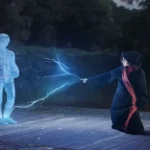Japanese Evil Names and Meanings – Japanese mythology and folklore are rich with stories of deities, spirits, and otherworldly beings that shape the world of both good and evil. Japan’s intricate tapestry of legends includes numerous evil entities, demons, and malevolent spirits that reflect the nation’s complex spiritual beliefs. These dark forces, often known as yokai, oni, or akuma, feature prominently in traditional tales, art, and modern pop culture.
In this article, we’ll delve into Japanese evil names and their meanings, exploring their origins, characteristics, and influence on culture. From the fearsome oni to the deceptive kitsune, Japanese folklore presents a fascinating world where the boundaries between good and evil are often blurred.
1. Oni (鬼): The Demonic Beasts of Hell
Meaning and Origin:
The word “Oni” (鬼) in Japanese translates to demon or ogre, and these fearsome creatures have been a staple of Japanese folklore for centuries. Oni are typically depicted as large, brutish figures with horns, sharp claws, and wild hair, often carrying massive clubs known as kanabo. Their skin is frequently painted in bold colors, such as red, blue, or green, symbolizing their demonic nature.
Characteristics:
Oni are known to be violent, terrifying beings that terrorize humans, often acting as tormentors in hell. However, they are not inherently evil. In some stories, oni are depicted as protectors or guardians, serving as both punisher and defender, depending on the context. The role of the oni can shift from that of a vengeful creature to one that enforces justice.
In Buddhist mythology, oni are sometimes portrayed as the guards of the underworld, where they punish the wicked for their sins. They are also seen as agents of death and destruction, sowing chaos wherever they go. Oni are often invoked as a symbol of raw power and malevolence, and they embody the destructive forces of nature.
Modern Influence:
Oni continue to have a strong presence in Japanese culture, appearing in festivals such as Setsubun, where beans are thrown to ward off these evil spirits. They also feature heavily in anime, manga, and video games, often playing the role of powerful enemies or antagonists.
2. Akuma (悪魔): The Japanese Devil
Meaning and Origin:
Akuma (悪魔) is the Japanese word for devil or demon and carries a deep association with pure evil. In Japan, Akuma are considered to be the personification of evil itself, much like the Christian concept of Satan. The term combines “aku” (悪), meaning evil, with “ma” (魔), meaning demon or spirit.
Characteristics:
Akuma are malevolent entities that delight in bringing misfortune and destruction to humans. They are often depicted with a fearsome and malevolent appearance, with horns, wings, and sharp claws. Unlike oni, who can sometimes be protective or neutral, akuma are always associated with pure evil and chaos.
In Japanese Christianity, the word “akuma” is used to refer to Satan, further emphasizing its association with absolute malevolence. While akuma are not as common in native Japanese folklore, the idea of a supreme evil being has been integrated into modern interpretations of demons and dark spirits.
Modern Influence:
Akuma appears in popular culture, especially in video games and anime, where the name is often given to demonic characters or villains. A famous example is the character Akuma from the Street Fighter video game series, who embodies the concept of a destructive, evil force.
3. Yurei (幽霊): The Restless Spirits
Meaning and Origin:
Yurei (幽霊) translates to ghost or phantom, and these spirits are typically the souls of those who have died with unresolved anger, sorrow, or unfinished business. They are the Japanese equivalent of Western ghosts, but their role in Japanese culture is more deeply intertwined with religious beliefs about the afterlife.
Yurei are closely connected to the Buddhist belief in karma and reincarnation. If someone dies a tragic or violent death, or if they have been wronged, their soul may become stuck in the mortal world as a yurei. These spirits are often depicted wearing white burial garments and with long, unkempt black hair, which has become a standard visual for ghosts in Japanese horror.
Characteristics:
Yurei haunt the living, seeking revenge or closure for the wrongs committed against them. They are often driven by intense emotions, such as anger, hatred, or sorrow, which makes them dangerous and unpredictable. Yurei are associated with specific locations, such as the place of their death or burial, and they usually appear during the hours of darkness.
Modern Influence:
Yurei have become iconic figures in Japanese horror (J-horror), with notable examples in films such as The Ring (Ringu) and Ju-On: The Grudge. These films brought yurei to a global audience, establishing them as some of the most terrifying and enduring figures in supernatural horror.
4. Jorogumo (絡新婦): The Spider Woman
Meaning and Origin:
The name Jorogumo (絡新婦) translates to binding bride or entangling bride, and this creature is a deadly yokai from Japanese folklore. Jorogumo is a shape-shifting spider demon who preys on unsuspecting men by transforming into a beautiful woman. In her spider form, she is enormous and terrifying, with venomous fangs and the ability to spin webs that can ensnare her victims.
Characteristics:
Jorogumo is seductive and cunning, using her appearance to lure men into her trap. Once she has ensnared them, she reveals her true spider form and devours them. This yokai embodies the themes of deception and temptation, often warning against the dangers of falling for outward appearances.
Jorogumo is closely linked to the natural world, particularly the mountains and forests where she is said to dwell. Her predatory nature makes her one of the more feared yokai in Japanese folklore.
Modern Influence:
The Jorogumo legend has inspired many stories in Japanese literature, theater, and pop culture. In modern anime and manga, characters inspired by Jorogumo often appear as seductive femme fatales with hidden, dangerous intentions.
5. Yuki-onna (雪女): The Snow Woman
Meaning and Origin:
Yuki-onna (雪女) means snow woman, and she is one of the most famous spirits in Japanese folklore. Yuki-onna is often depicted as a beautiful, pale woman who appears during snowstorms, wearing a white kimono. Despite her beauty, she is a deadly spirit who lures travelers to their death in the cold wilderness.
Characteristics:
Yuki-onna embodies the cold, unforgiving nature of winter. She is known to seduce or deceive men, often freezing them to death or leading them into dangerous, icy conditions. In some versions of the legend, she is capable of mercy, sparing certain individuals who show her kindness or plead for their lives.
Yuki-onna is a representation of the harshness of nature and the dangers of the winter landscape. She serves as both a warning and a force of retribution in folklore.
Modern Influence:
Yuki-onna has appeared in many forms of Japanese media, from literature to anime, often portrayed as a tragic, cold-hearted spirit. Her story continues to be retold in various formats, showcasing the timeless appeal of her legend.
6. Gashadokuro (餓者髑髏): The Starving Skeleton
Meaning and Origin:
Gashadokuro (餓者髑髏) translates to starving skeleton, and it is one of the most terrifying creatures in Japanese mythology. These enormous skeletons, towering over buildings, are said to be the spirits of those who died from starvation or in battle, left unburied and forgotten.
Characteristics:
Gashadokuro wander the land at night, seeking out lone travelers to capture and devour. Their approach is often silent, but some legends claim that a ringing sound in one’s ears signifies that the gashadokuro is nearby. They are known for their immense strength and the ability to crush their victims with ease.
The creation of a gashadokuro is fueled by intense anger and bitterness, making them vengeful spirits that wreak havoc on the living. Their skeletal appearance and enormous size make them a fearsome sight, embodying the horror of death and the consequences of neglecting the dead.
Modern Influence:
Gashadokuro has inspired countless works in Japanese pop culture, including anime, video games, and movies. The image of a giant, undead skeleton continues to resonate as one of the most striking symbols of evil in Japanese mythology.
7. Shuten-dōji (酒呑童子): The Drunken Demon
Meaning and Origin:
Shuten-dōji (酒呑童子) is one of Japan’s most famous oni, renowned for his immense strength, cruelty, and love of sake. His name translates to drunken boy or drunken demon, and he was the leader of a gang of demons that terrorized the capital of Japan.
Characteristics:
Shuten-dōji was known for abducting young women and feasting on human flesh. His drunkenness often made him even more dangerous, as he would become unpredictable and violent. In legend, he was ultimately slain by a group of heroes who disguised themselves as monks to infiltrate his lair. They offered him poisoned sake, which weakened him before they decapitated him.
Shuten-dōji represents the combination of brutality and indulgence, warning against the dangers of excess and unrestrained power.
Modern Influence:
Shuten-dōji has become a popular figure in Japanese storytelling, often appearing in books, plays, and modern media. His tale is one of the most famous in Japanese folklore, and he continues to inspire new interpretations in anime, manga, and theater.
8. Kitsune (狐): The Trickster Fox
Meaning and Origin:
The kitsune (狐) is a fox spirit that is both revered and feared in Japanese mythology. Kitsune are known for their shape-shifting abilities, often taking the form of beautiful women or elderly men to deceive humans.
Characteristics:
Kitsune are tricksters, known for playing pranks on humans or leading them astray. Some kitsune serve as protectors of shrines, while others are malevolent, using their powers to harm those who wrong them. Their ability to transform and deceive makes them one of the most unpredictable and dangerous spirits in Japanese folklore.
Kitsune can be either benevolent or malevolent, depending on the story. They are often associated with Inari, the god of rice, and are believed to be messengers of the gods.
Modern Influence:
Kitsune continue to be popular in Japanese media, from anime to novels, often portrayed as complex characters who walk the line between good and evil. Their shape-shifting abilities make them fascinating subjects for storytelling – Japanese Evil Names and Meanings.
Conclusion
Japanese mythology offers a rich array of evil spirits, demons, and malevolent entities that play significant roles in both traditional and modern narratives. The names and meanings behind these creatures, such as Oni, Akuma, and Yurei, reveal the complex and multifaceted nature of good and evil in Japanese culture. Whether as symbols of chaos, revenge, or deception, these spirits have left an indelible mark on both the folklore of Japan and global pop culture – Japanese Evil Names and Meanings.
FAQs
1. What does “Oni” mean in Japanese folklore?
“Oni” refers to demonic creatures in Japanese mythology, known for their immense strength and violent tendencies.
2. What is the role of Yurei in Japanese culture?
Yurei are restless spirits that haunt the living, often driven by unresolved emotions such as anger or sorrow.
3. Who is Shuten-dōji?
Shuten-dōji is a famous oni in Japanese folklore known for his cruelty, strength, and love of sake.
4. Are Kitsune considered evil in Japanese mythology?
Kitsune are complex beings that can be either benevolent or malevolent, depending on the story.
5. What is the significance of Akuma in Japanese culture?
Akuma represents the concept of absolute evil, similar to the idea of Satan in Western religions.
6. How does Gashadokuro differ from other yokai?
Gashadokuro are giant skeletons formed from the spirits of those who died from starvation, known for their immense size and strength.







